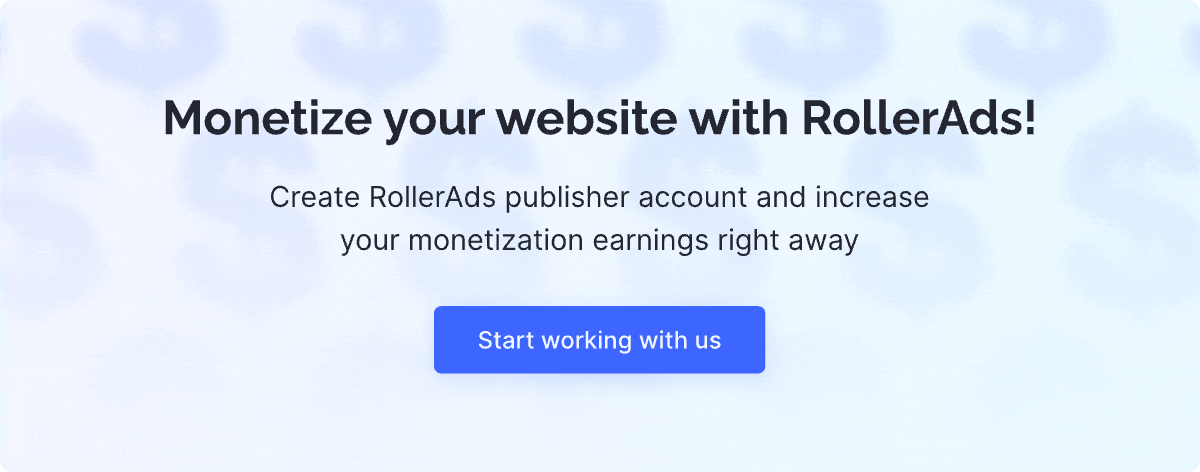Ranking on the first page in Google’s search results was not always the most coveted goal of a publisher. There was a time when Google was experimenting with a continuous feed, featuring no pages at all.
In 2024, we experienced a similar kind of revolution when Google began providing AI Overviews for the majority of user requests. And now website owners and advertisers begin to explore the realm of Answer Engine Optimization (AEO).
It’s time to elaborate on AEO, so that you know how to get in there, what makes it different from SEO, and how RollerAds can help you along the way.
AI Overviews Explained
The Google AI Overview is a summary that appears immediately below the search bar after you enter a query. It functions as an AI assistant, compiling a summary of the topic in question based on multiple sources. Every summary contains links to the source of information so that you can verify every bit of info. It was introduced back in 2024 with the experimental Search Generative Experience version.
AI summaries are a convenient way to tap into new info already, but their potential goes beyond just that. If you own a website, you may want to be mentioned there to attract more visitors to your site. Whether it’s a full-scale overview dedicated to your website or just a link, it’s good for your SEO and organic traffic share.
How AI Overviews Work
According to the definition from Google, AIO uses generative AI, a type of artificial intelligence that learns patterns and structures from the data it is trained on and uses those to create something new.
To put it simply: when you ask a question, the AI first tries to figure out what you really want to know. Then, it looks through a huge library of websites to find the most helpful and trustworthy answers related to your question. It picks the best sources it can find. Next, the AI combines all the information it has found into a concise, clear summary answer.
AEO vs. SEO
You already know about SEO (Search Engine Optimization), when you perform the best website practices to get featured in Google’s top 10 search results. Answer Engine Optimization (AEO) is somewhat similar, yet there are subtle differences that we’re bound to tell you about.
The primary difference between AEO and SEO lies in their focus. SEO traditionally focuses on improving rankings by optimizing keyword usage, building backlinks, and enhancing metadata for search engines. AEO, on the other hand, optimizes content for AI systems by focusing on concise answers, authority, and factual accuracy. AEO emphasizes generating direct, conversational responses that AI overviews can summarize, prioritizing user experience over long-form, keyword-heavy content.
AEO means you need to optimize your content specifically for your topic. This includes making language more transparent, adding reliable sources, and improving readability. This shift to AEO happened because users now prefer direct, AI-made answers instead of just a list of website links. It changes how creators get their content seen and stay relevant.

How to Get Mentioned in AIO
The first way is to simply follow Google’s advice: you can use regular SEO tactics, and they will work just fine. It’s a tried-and-true approach, but you can go deeper than that. For example, the study called GEO: Generative Engine Optimization mentioned several strategies on how to write your texts in order to get into AIO:
Use a strong and confident tone of voice (TOV). This is crucial for establishing authority and fostering a sense of trust. Grammar checkers, e.g., Grammarly, can help you with that. After all, if you want to score high on the AI ranking, what can be better than to use another AI?
No keyword stuffing. This is where parallels with SEO become obvious; keyword chains are long gone and won’t work here either at best, or kill your AOE advance at worst.
Include statistics and charts. AI loves when there are specific numbers and data to support any claim of yours. Do your best to find relevant content for your site to improve its ranking in AOE.
Cite credible sources. Favor trustworthy experts or credible publications to improve the trustworthiness of your content. Back up every important claim with a link to the source material.
Add expert quotes. Consider incorporating a handful of expert quotes throughout to enhance authority and provide context.
Make your ideas succinct. You need to simplify your language, but at the same time say everything you have on the topic. Puzzling grammar constructions obstructing one’s understanding of the text’s essence is detrimental to AOE vs. complex phrases can ruin your AOE ranking.
Optimize for smooth reading. Your text should be easy to read and flow naturally. Consider limiting yourself to 2–4 sentences per paragraph. Also, make it easy to scan your text by bringing the key ideas upfront. Finally, reread what you have written to ensure clarity, cohesion, and simplicity—your texts ought to be succinct.
Incorporate unique phrases. Try to identify the key phrases or angles that make your content stand out.
Use technical terms. While keeping things clear and concise, consider incorporating a few scientific terms to demonstrate your credibility and make your content stand out in queries. After all, both students and professors search online, and their vocabulary might prove to be very different.
Speaking of statistics and charts, a study targeted the correlation between a page’s position and the likelihood of being cited in AIO. During the research and experiments, it was concluded that, although AIO appears to analyze and examine everything, in fact, it often only cites the top three links:
- Rank #1 gets cited ~18.5% of the time
- Rank #2 and lower ~15.6%
- Rank #10 about 2%
Lower than that, your chances of getting cited are around 0%. Thus, a reliable way to access the AI Overview is to follow SEO strategies and rank at the top of the list. Why would you want to? Because results showed a potential 40% boost in content visibility through AEO-specific methods, creating a positive loop.
Of course, SEO and AEO are not the same, and their correlation doesn’t clarify causality. It’s debatable whether SEO contributes to AEO or vice versa, so we suggest developing both for maximum synergy. Besides, it’s just a single research study, and the field of AEO is relatively new, so more findings are likely to emerge over time.
AIO and Google Discover
The AI Overview is being tested within Google Discover, as all these features belong to the same company; however, this is still an experimental and limited-scope feature.
Some users can see quick AI summaries when they tap “more” on articles in their Discover feed. While this uses technology related to Search AI Overviews, it’s a specific feature for Discover and not yet a fully launched or widely available integration.
Monetizing AIO with RollerAds
While the AI Overview feature is relatively new, you can already monetize traffic from it with RollerAds.
First, we’ll assess your website and design an optimal monetization strategy for you. Then, our support team will assist you in setting up an ads tailored specifically for your content. We specialize in helping you fully monetize your traffic across multiple formats. In addition to push notifications, we offer high-performing options like OnClick (Pop) and Direct Click ads—perfect for both standard and AEO traffic.
What sets push notifications apart is their ability to grow a loyal subscriber base. Unlike other ad formats, push lets you engage users beyond just ads. You can use our hybrid format to deliver a mix of content: news, updates, blog posts, and more.
Much like Google Discover, AEO traffic typically consists of first-time visitors. Encourage them to subscribe to your push notifications to keep them engaged from the start.
Last Thoughts
At RollerAds, we’re here to help you increase both your revenue and your website’s appeal to your target audience. Many of our publishers start earning quickly—one even scaled from $0 to $60K in just 4 months!
Want results like that? Sign up now to start profiting with the team of professionals!






